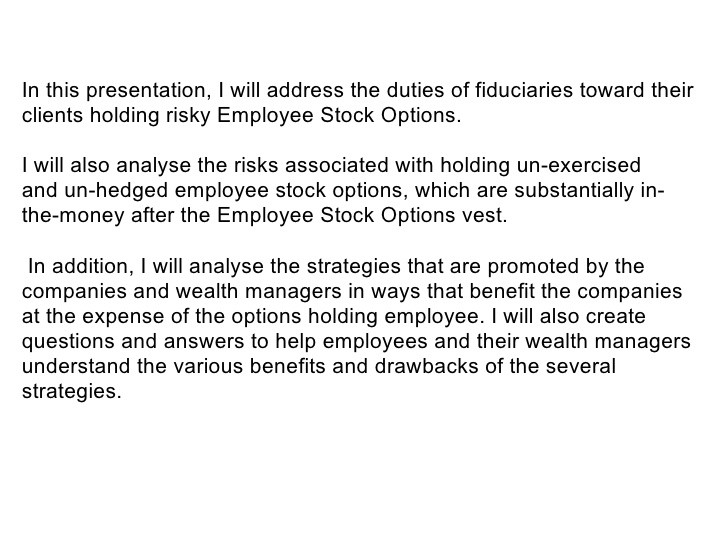An Introduction to Employee Stock Options
Post on: 5 Май, 2015 No Comment

How Do Employee Stock Options Work
Employees who are granted stock options hope to profit by receiving the shares to which they’re entitled. In essence, they look to exercise their options at a higher price than when the options were originally granted, thereby pocketing the difference so to say; one thing to note is that the price at which the options are granted at is known as the exercise price .
For starters, employees are not typically granted full ownership of the options on the initiation date of the contract, which is more commonly known as the grant date. Your right to exercise the options is subject to a vesting schedule. For example, with some option grants, all shares are vested within a year, while many others offer a graduated vesting scheme, where a certain percentage of shares are exercisable after one year, another percentage after two years, and so on.
After the vesting schedule comes the expiration date ; upon this date, the employer no longer reserves the right for its employees to purchase the company stock under the terms originally specified in the ESO agreement.
Keep in mind that employee stock options are a way for companies to align their interests with those of employees; if the company thrives, employees stand to benefit. This may be further magnified by the fact that some companies grant options at a discount to the stock’s market value.
Types of ESOs
There are two main types of options, nonqualified options and incentive options. The key way they differ is in how they are taxed.
- Nonqualified Employee Stock Options
Nonqualified ESOs are the type of options used for broad-based plans. Generally, employees owe no tax when these options are granted, but are required to pay ordinary income tax on the spread between the grant price and the stock’s market value when the shares are purchased. Nonqualified options may be granted at a discount to the stock’s market value. They can also be transferred to family members or charities if the issuing company allows for it.
- Incentive Stock Options (ISOs)
Incentive stock options, also known as “qualified” stock options, differ from the nonqualified variety in that they receive special tax treatment. When the option is granted and exercised, no tax is due. Instead, tax liability is deferred until the stock is sold, at which time the entire gain is taxed at long-term capital gains rates (as long as the stocks are sold at least one year after they are exercised and two years after the option is granted).Unlike nonqualified options, ISOs can’t be granted at a discount to the stock’s market value. They also can’t be transferred other than through the holder’s will.
Exercising ESOs

It’s in exercising ESOs that things get tricky. For example, suppose that you’re granted 500 options at a price of $10 each and that at the end of the first year, you have the right to exercise 100 shares of stock. Now, let’s suppose that the market price for the company’s stock at that time is $15 per share. This is called being “in the money,” because you have the opportunity to buy the stock for $5 below the market price. Then, if you sell those stocks, you’ll realize a $500 profit (pre-tax).
If, on the other hand, the company’s stock price is $8 per share, you would not exercise your options. This is called being “out of the money” or “underwater,” and you don’t exercise because this would essentially mean paying $10 for a stock you could get for $8 on the open market. However, this is only a paper loss, and if you hang on to your options and the stock’s market price rises above $10, you can exercise at that time. If you’re looking to get involved in dividend stocks, get prepared with these 41 Inspiring And Intelligent quotes.
When you decide to exercise your ESOs depends on your investing strategy. If you believe in a long-term strategy, you might sit on your options until they are about to expire (which usually occurs within 10 years). This allows the stock to appreciate, so that employees can maximize their gain. However, there are also a couple of sound reasons for exercising early:
- You no longer believe in the company and its stock.
- You have too many company shares. One key problem with investing in ESOs is that they can put an employee’s portfolio out of balance. As with any other stock, ESOs should be part of an asset allocation strategy that’s balanced out by other investments.
- You don’t want to be pushed into a higher tax bracket. Remember that nonqualified ESOs are subject to tax when they are exercised. That means that avoiding exercising them all at once might be a good idea from a tax perspective.
Taxes
Tax treatment of ESOs is one of the trickier things about them. Exactly how you are taxed will depend on the type of options you’re exercising; other individual variables may come into play as well. Therefore, it’s a good idea to consult with a tax professional before you exercise your options and/or sell shares.
For example, suppose that you’re granted the option to buy 1,000 shares at $5 per share. Now suppose that you’re forced to exercise them at that price before they expire. In this case, you’ll owe income tax on what the IRS considers a $5,000 profit, even though you never saw the cash. Confused? That’s why it’s great to get professional advice in these situations.
ESOs and Your Portfolio
There are a couple of issues that are particular to ESOs that investors should be aware of. The first is that, as we mentioned above, they still need to be part of a balanced portfolio. The other is the question of why you’re buying shares in your own company in the first place. There’s a whole wide world of stocks to buy out there, and while many employees get stock options because it’s easy to do, they should really approach the potential transaction with the same care and attention they would when picking any stock. Plus, some people argue that ESOs put employees at greater risk than other stocks; if the company fails, it affects both the employee’s portfolio and his or her livelihood.
If you believe in the company you work for and its prospects, have at it. If you aren’t so sure, there’s no shortage of other stocks on the market to choose from. For starters, check out some of the firms featured in our Best Dividend Stocks list.
The Bottom Line
ESOs are a bit trickier to understand than simple stocks, but it’s important that employees take the time to do so before they buy in. These options can provide good investment opportunities, but they also present some tax traps and other issues that can easily become costly. So, before you invest, get to know the basics not only of investing in ESOs, but in the stock market as well. When it comes to investing in either, knowledge is the key to profit.














